The Question is unclear, in that as described by @mkl both are the same contents just different ways of setting and thus viewing the lines of text.
This query is caused by the way lines of text are broken into sub units, such that the "Lines" are often multiple parts as text "blocks" with what seem to be separated characters (which is called "kerning").
So in this case that kerning is generally not needed, let me show you one alternate way of writing those lines. Here is the first "paragraph" but note there is no such distinction in a PDF each line is in effect "standalone" (or several standalones :-)
NOTE these are first FIVE lines of text placed as NINE blocks (two are just simply a space character, in the same line.)
q 0.24 0 0 0.24 50.05992 729.02 cm BT 0.0029 Tc 58 0 0 58 0 0 Tm /F4.0 1 Tf [ (be) 1 ( ) 2 (t) 2 (r) 1 (ue) 1 (.) 2 ( ) 2 ( ) 2 (C) -1 (e) 1 (r) 1 (t) 2 (a) 1 (i) 2 (nl) 2 (y ) 2 (t) 2 (he) 1 (r) 1 (e) 1 ( ) 2 (a) 1 (r) 1 (e) 1 ( ) 2 (c) 1 (r) 1 (i) 2 (t) 2 (i) 2 (c) 1 (a) 1 (l) 2 ( ) 2 (a) 1 (s) 1 (pe) 1 (c) 1 (t) 2 (s) 1 ( ) 2 (of) 1 ( ) 2 (t) 2 (he) 1 ( ) 2 (t) 2 (he) 1 (or) 1 (y ) 2 (l) 2 (e) 1 (f) 1 (t) 2 ( ) 2 (unt) 2 (e) ] TJ ET Q
q 0.24 0 0 0.24 414.2992 729.02 cm BT 0.0024 Tc 58 0 0 58 0 0 Tm /F4.0 1 Tf [ (st) 1 (ed) -1 ( ) 1 (i) 1 (n) -1 ( ) 1 (o) -1 (u) -1 (r) 1 ( ) 1 (st) 1 (u) -1 (d) -1 (y) -1 (.) 1 ( ) 1 ( ) 1 (W) -3 (h) -1 (er) 1 (e,) 1 ( ) ] TJ ET Q
q 0.24 0 0 0.24 50.05992 711.02 cm BT 0.0024 Tc 58 0 0 58 0 0 Tm /F4.0 1 Tf [ (fo) -1 (r) 1 ( ) 1 (ex) -1 (am) -2 (p) -1 (l) 1 (e,) 1 ( ) 1 (i) 1 (s ) 1 (t) 1 (h) -1 (er) 1 (e ) 1 (an) -1 (y) -1 ( ) 1 (d) -1 (i) 1 (r) 1 (ect) 1 ( ) 1 (ev) -1 (i) 1 (d) -1 (en) -1 (ce ) 1 (o) -1 (f ) 1 (Òau) -1 (r) 1 (asÓ?) 2 ( ) 1 ( ) 1 (A) -2 (l) 1 (t) 1 (h) -1 (o) -1 (u) -1 (g) -1 (h) -1 ( ) 1 (t) 1 (h) -1 (ey) -1 ( ) 1 (ar) 1 (e ) 1 (t) 1 (h) -1 (eo) -1 (r) 1 (i) 1 (zed) -1 ( ) 1 (t) 1 (o) -1 ( ) 1 (b) -1 (e ) 1 (t) 1 (h) -1 (e ) ] TJ ET Q
q 0.24 0 0 0.24 50.05992 693.02 cm BT 0.0024 Tc 58 0 0 58 0 0 Tm /F4.0 1 Tf [ (cr) 1 (i) 1 (t) 1 (i) 1 (cal) 1 ( ) 1 (l) 1 (i) 1 (n) -1 (k) -1 ( ) 1 (b) -1 (et) 1 (w) -2 (een) -1 ( ) 1 (t) 1 (h) -1 (e ) 1 (ci) 1 (g) -1 (ar) 1 (et) 1 (t) 1 (e ) 1 (an) -1 (d) -1 ( ) 1 (ar) 1 (m) -2 ( ) 1 (st) 1 (r) 1 (en) -1 (g) -1 (t) 1 (h) -1 (,) 1 ( ) 1 (w) -2 (e ) 1 (h) -1 (av) -1 (e ) 1 (o) -1 (b) -1 (t) 1 (ai) 1 (n) -1 (ed) -1 ( ) 1 (n) -1 (o) -1 ( ) 1 (ev) -1 (i) 1 (d) -1 (en) -1 (ce ) 1 (t) 1 (h) -1 (at) 1 ( ) ] TJ ET Q
q 0.24 0 0 0.24 50.05992 675.02 cm BT 0.0024 Tc 58 0 0 58 0 0 Tm /F4.0 1 Tf [ (Òn) -1 (eg) -1 (at) 1 (i) 1 (v) -1 (el) 1 (y) -1 ( ) 1 (i) 1 (n) -1 (t) 1 (er) 1 (act) 1 (i) 1 (n) -1 (g) -1 ( ) 1 (au) -1 (r) 1 (asÓ ) 1 (ex) -1 (i) 1 (st) 1 ( ) 1 (o) -1 (r) 1 ( ) 1 (p) -1 (l) 1 (ay) -1 ( ) 1 (an) -1 (y) ] TJ ET Q
q 0.24 0 0 0.24 313.6195 675.02 cm BT 58 0 0 58 0 0 Tm /F4.0 1 Tf ( ) Tj ET Q
q 0.24 0 0 0.24 317.1195 675.02 cm BT 0.0019 Tc 58 0 0 58 0 0 Tm /F4.0 1 Tf [ (ro) -1 (l) 1 (e) -1 ( ) 1 (i) 1 (n) -1 ( ) 1 (t) 1 (h) -1 (e) -1 ( ) 1 (p) -1 (ro) -1 (c) -1 (e) -1 (s) -1 (s) -1 (.) ] TJ ET Q
q 0.24 0 0 0.24 422.8646 675.02 cm BT 58 0 0 58 0 0 Tm /F4.0 1 Tf ( ) Tj ET Q
q 0.24 0 0 0.24 100.0599 657.02 cm BT 0.0053 Tc 58 0 0 58 0 0 Tm /F4.0 1 Tf [ (Mo) 2 (s) 3 (t) 4 ( ) 4 (c) 3 (r) 3 (i) 4 (t) 4 (i) 4 (c) 3 (a) 3 (l) 4 (l) 4 (y) 2 (,) 4 ( ) 4 (h) 2 (o) 2 (w) 1 (e) 3 (v) 2 (e) 3 (r) 3 (,) 4 ( ) 4 (w) 1 (e) 3 ( ) 4 (n) 2 (e) 3 (e) 3 (d) 2 ( ) 4 (t) 4 (o) 2 ( ) 4 (r) 3 (e) 3 (c) 3 (a) 3 (l) 4 (l) 4 ( ) 4 (t) 4 (h) 2 (e) 3 ( ) 4 (p) 2 (r) 3 (o) 2 (p) 2 (o) 2 (s) 3 (i) 4 (t) 4 (i) 4 (o) 2 (n) 2 (a) 3 (l) 4 ( ) 4 (r) 3 (e) 3 (a) 3 (s) 3 (o) 2 (n) 2 (i) 4 (n) 2 (g) 2 ( ) 4 (t) 4 (h) 2 (a) 3 (t) 4 ( ) 4 (f) 3 (o) 2 (r) 3 (m) 1 (s) 3 ( ) ] TJ ET Q

Here we see in an editor the 9 content lines on the left, and I have highlighted on right the 8th line at end of the 4th visible printer output.

We can simplify that down to 5 lines (without kerning) to say this format:-
q 0.24 0 0 0.24 50.05992 729.02 cm BT 0.0029 Tc 58 0 0 58 0 0 Tm /F4.0 1 Tf [ (be true. Certainly there are critical aspects of the theory left untested in our study. Where, ) ] TJ ET Q
q 0.24 0 0 0.24 50.05992 711.02 cm BT 0.0024 Tc 58 0 0 58 0 0 Tm /F4.0 1 Tf [ (for example, is there any direct evidence of ÒaurasÓ? Although they are theorized to be the ) ] TJ ET Q
q 0.24 0 0 0.24 50.05992 693.02 cm BT 0.0024 Tc 58 0 0 58 0 0 Tm /F4.0 1 Tf [ (critical link between the cigarette and arm strength, we have obtained no evidence that ) ] TJ ET Q
q 0.24 0 0 0.24 50.05992 675.02 cm BT 0.0024 Tc 58 0 0 58 0 0 Tm /F4.0 1 Tf [ (Ònegatively interacting aurasÓ exist or play any role in the process. ) ] TJ ET Q
q 0.24 0 0 0.24 100.0599 657.02 cm BT 0.0053 Tc 58 0 0 58 0 0 Tm /F4.0 1 Tf [ (Most critically, however, we need to recall the propositional reasoning that forms ) ] TJ ET Q
so what would be the effect ?
In this case there would be no problem however let me show you the way it minimally alters content for a large reduction in file size.
Here the First Line and a Half have been replaced by the condensed FIVE Lines and the Red second Half is the old (RED) underlaid with the new.
There is no real discernible difference in final placement. So the 3rd and 4th lines are old on top of new and again there is such small difference, that I defy a "Person on a galloping horse" or an average reader, to see the displaced characters in last words "that" and "process".

However with the 5th Line we can see a difference, but does it matter? Let me remove the old bloated one. Would you really know it was the shorter one that went ? And the FileSize is 2084 bytes shorter, as a result from cleaning up three and a half line lengths !

Answer
Simply remove kerning between ) -4 ( ... to ... ) 4 ( will in most cases reduce file size significantly without too much degradation of appearance. However you need to check in cases where line scaling is impacted by removing those tweaking twips.





